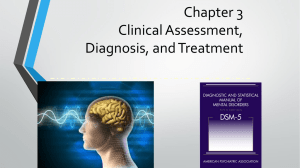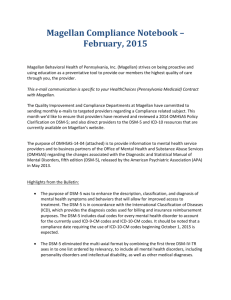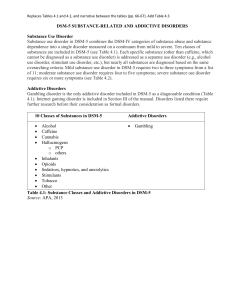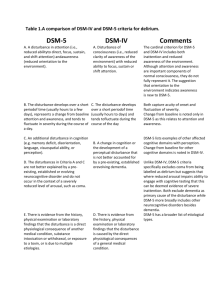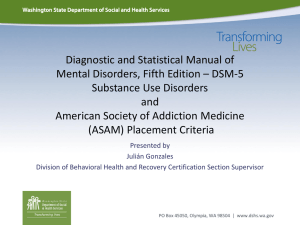Insurance Implications of DSM-5 - American Psychiatric Association
advertisement
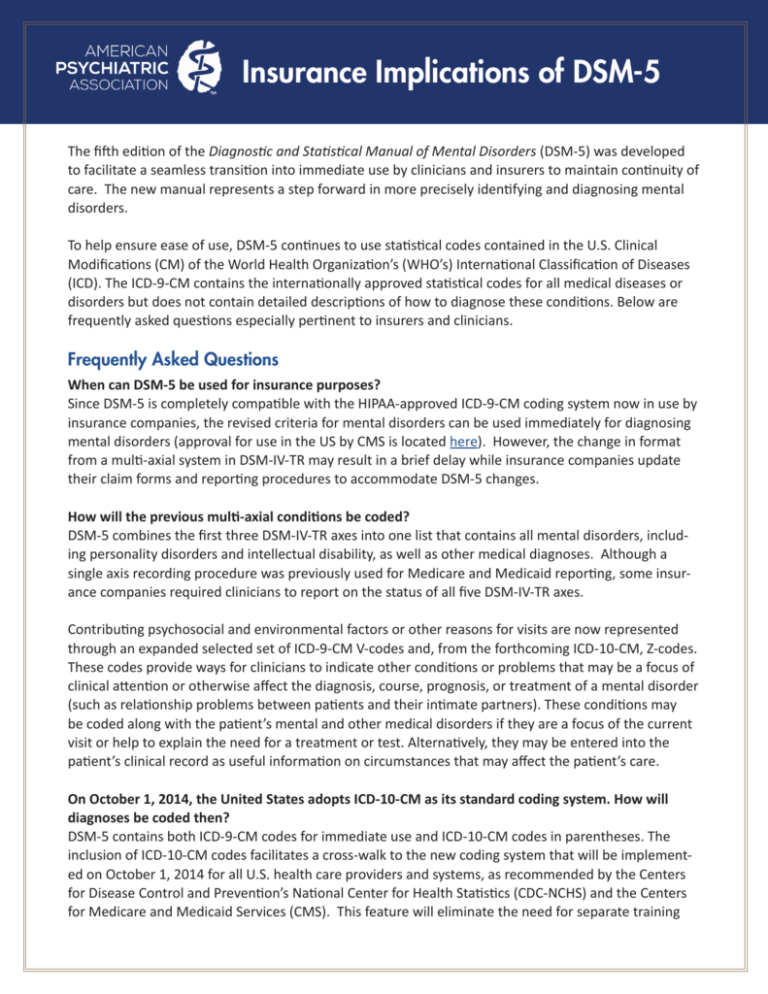
Insurance Implications of DSM-5 The fifth edition of the Diagnostic and Statistical Manual of Mental Disorders (DSM-5) was developed to facilitate a seamless transition into immediate use by clinicians and insurers to maintain continuity of care. The new manual represents a step forward in more precisely identifying and diagnosing mental disorders. To help ensure ease of use, DSM-5 continues to use statistical codes contained in the U.S. Clinical Modifications (CM) of the World Health Organization’s (WHO’s) International Classification of Diseases (ICD). The ICD-9-CM contains the internationally approved statistical codes for all medical diseases or disorders but does not contain detailed descriptions of how to diagnose these conditions. Below are frequently asked questions especially pertinent to insurers and clinicians. Frequently Asked Questions When can DSM-5 be used for insurance purposes? Since DSM-5 is completely compatible with the HIPAA-approved ICD-9-CM coding system now in use by insurance companies, the revised criteria for mental disorders can be used immediately for diagnosing mental disorders (approval for use in the US by CMS is located here). However, the change in format from a multi-axial system in DSM-IV-TR may result in a brief delay while insurance companies update their claim forms and reporting procedures to accommodate DSM-5 changes. How will the previous multi-axial conditions be coded? DSM-5 combines the first three DSM-IV-TR axes into one list that contains all mental disorders, including personality disorders and intellectual disability, as well as other medical diagnoses. Although a single axis recording procedure was previously used for Medicare and Medicaid reporting, some insurance companies required clinicians to report on the status of all five DSM-IV-TR axes. Contributing psychosocial and environmental factors or other reasons for visits are now represented through an expanded selected set of ICD-9-CM V-codes and, from the forthcoming ICD-10-CM, Z-codes. These codes provide ways for clinicians to indicate other conditions or problems that may be a focus of clinical attention or otherwise affect the diagnosis, course, prognosis, or treatment of a mental disorder (such as relationship problems between patients and their intimate partners). These conditions may be coded along with the patient’s mental and other medical disorders if they are a focus of the current visit or help to explain the need for a treatment or test. Alternatively, they may be entered into the patient’s clinical record as useful information on circumstances that may affect the patient’s care. On October 1, 2014, the United States adopts ICD-10-CM as its standard coding system. How will diagnoses be coded then? DSM-5 contains both ICD-9-CM codes for immediate use and ICD-10-CM codes in parentheses. The inclusion of ICD-10-CM codes facilitates a cross-walk to the new coding system that will be implemented on October 1, 2014 for all U.S. health care providers and systems, as recommended by the Centers for Disease Control and Prevention’s National Center for Health Statistics (CDC-NCHS) and the Centers for Medicare and Medicaid Services (CMS). This feature will eliminate the need for separate training on ICD-10-CM codes for mental disorders that is now being offered for all other diseases/disorders by other medical societies and vendors to prepare for the 2014 implementation. With the removal of the multiaxial system in DSM-5, how will disability and functioning be assessed? The Global Assessment of Functioning (GAF) scale, recommended for Axis V in the DSM-IV multiaxial assessment, combined assessment of symptom severity, dangerousness to self or others, and decrements in self-care and social functioning into a single global assessment. The GAF was used for determinations of medical necessity for treatment by many payers, and eligibility for short- and long-term disability compensation. Clinician-researchers at the APA have conceptualized need for treatment as based on assessments of diagnosis, severity of symptoms and diagnosis, dangerousness to self or others, and disability in social and self-care spheres. We do not believe that a single score from a global assessment, such as the GAF, conveys information to adequately assess each of these components, which are likely to vary independently over time. Further, we are concerned about evidence that the GAF requires specific training for proper use, and that good reliability and prediction of outcomes in routine clinical practice may depend on such training. Therefore, we are recommending that clinicians continue to assess the risk of suicidal and homicidal behavior (for example, see the APA’s Clinical Practice Guidelines for Suicidal Behaviors) and use available standardized assessments for symptom severity, diagnostic severity, and disability such as the measures in Section III of DSM-5. For those who relied on the use of a GAF number, there will clearly be a transitional period from the GAF to the use of separate assessments of severity and disability. The World Health Organization Disability Assessment Schedule (WHODAS 2.0) was judged by the DSM-5 Disability Study Group to be the best current measure of disability for routine clinical use. The WHODAS 2.0 is based on the International Classification of Functioning, Disability, and Health (ICF) and is applicable to patients with any health condition, thereby bringing DSM-5 into greater alignment with other medical disciplines. It was tested in the DSM-5 field trials and found to be feasible and reliable in routine clinical evaluations. This change in the recommended assessment is consistent with WHO recommendations to move toward a clear conceptual distinction between the disorders contained in the ICD and the disabilities resulting from disorders, which are described in the ICF. Sometimes different disorders or subtypes share the same diagnostic code. Is this an error? No. It is occasionally necessary to use the same code for more than one disorder. Because the DSM-5 diagnostic codes are limited to those contained in the ICD, some disorders must share codes for recording and billing purposes. For example, hoarding disorder and obsessive-compulsive disorder share the same codes (ICD-9-CM 300.3 and ICD-10-CM F42). Because there may be multiple disorders associated with a given ICD-9-CM or ICD-10-CM code, the DSM-5 diagnosis should be always be recorded by name in the medical record in addition to listing the code. 2 • Insurance Implications of DSM-5 The names of some DSM-5 disorders do not match the names of the ICD disorders, even though the code is the same. Can you explain this? Because the DSM-5 diagnostic codes are limited to those contained in the ICD, new DSM-5 disorders were assigned the best available ICD codes. The names connected with these ICD codes sometimes do not match the DSM-5 names. For example, DSM-5 disruptive mood dysregulation disorder (DMDD) is not listed in the ICD. The best ICD-9-CM code available for DSM-5 use was 296.99 (other specified episodic mood disorder). For ICD-10-CM the code will be F34.8 (other persistent mood [affective] disorders). Please refer to the table below for other examples. APA will be working with CDC-NCHS and CMS to include new DSM-5 terms in the ICD-10-CM, and will inform clinicians and insurance companies when modifications are made. Because DSM-5 and ICD disorder names may not match, the DSM-5 diagnosis should always be recorded by name in the medical record in addition to listing the code. DSM-5 Disorder DSM-5/ICD-9-CM CD-9-CM Title Code (in use through DSM-5/ICD-10-CM ICD-10-CM Title Code (in use starting Social (pragmatic) communication disorder 315.39 Other developmental speech or language disorder F80.89 Other developmental disorders of speech and language Disruptive mood dysregulation disorder 296.99 Other specified episodic mood disorder F34.8 Other persistent mood [affective] disorders Premenstrual dysphoric disorder 625.4 Premenstrual tension syndromes N94.3 Premenstrual tension syndrome Hoarding disorder 300.3 Obsessive-compulsive disorders F42 Obsessive- compulsive disorder Other specified obses- 300.3 sive compulsive and related disorder Obsessive-compulsive disorders F42 Obsessive- compulsive disorder Unspecified obsessive compulsive and related disorder 300.3 Obsessive-compulsive disorders F42 Obsessive- compulsive disorder Excoriation (skin picking) disorder 698.4 Dermatitis factitia [artefacta] L98.1 Factitial dermatitis Binge eating disorder 307.51 Bulimia nervosa F50.8 Other eating disorders September 30, 2014) October 1, 2014) How are DSM-5 and ICD related? DSM-5 and the ICD should be thought of as companion publications. DSM-5 contains the most up-todate criteria for diagnosing mental disorders, along with extensive descriptive text, providing a common language for clinicians to communicate about their patients. The ICD contains the code numbers used in DSM-5 and all of medicine, needed for insurance reimbursement and for monitoring of morbidity and mortality statistics by national and international health agencies. The APA works closely with staff from the WHO, CMS, and CDC-NCHS to ensure that the two systems are maximally compatible. The CMS response to a Frequently Asked Question (FAQ) about the relationship between DSM and ICD9-CM can be found here. Insurance Implications of DSM-5 • 3 How is information from DSM-5 used? DSM-5 is the handbook used by health care professionals in the United States and much of the world as the authoritative guide to the diagnosis of mental disorders. Clinicians use DSM-5 diagnoses to communicate with their patients and with other clinicians, and to request reimbursement from insurance organizations. DSM-5 diagnoses may also be used by public health authorities for compiling and reporting morbidity and mortality statistics. Another important role of DSM is to establish diagnoses for research on mental disorders. Only by having consistent and reliable diagnoses can researchers determine the risk factors and causes for specific disorders, and determine their incidence and prevalence rates. Can clinicians continue to use the DSM-IV-TR diagnostic criteria? Clinicians may use DSM-5 in their practices immediately. However, there may be brief delays while insurance companies update their claim forms and reporting procedures to accommodate DSM-5 changes, and clinicians should use DSM-IV-TR diagnoses and codes when required by a specific company. Transition details are still being developed with CDC-NCHS, CMS, and private insurance agencies. The APA is working with these groups with the expectation that a transition to DSM-5 by the insurance industry can be made by December 31, 2013. As part of the transition to DSM-5, there will also need to be updates of questions in board certification examinations and quality assessments for medical record reviews. APA will be providing periodic updates of agreements with federal agencies, private insurance companies, and medical examination boards as they become available. DSM is the manual used by clinicians and researchers to diagnose and classify mental disorders. The American Psychiatric Association (APA) will publish DSM-5 in 2013, culminating a 14-year revision process. For more information, go to www. DSM5.org. APA is a national medical specialty society whose more than 36,000 physician members specialize in the diagnosis, treatment, prevention and research of mental illnesses, including substance use disorders. Visit the APA at www.psychiatry.org. For more information, please contact Eve Herold at 703-907-8640 or press@psych.org. © 2013 American Psychiatric Association Order DSM-5 and DSM-5 Collection at www.appi.org 4 • Insurance Implications of DSM-5
